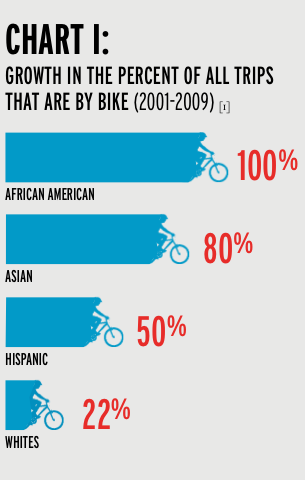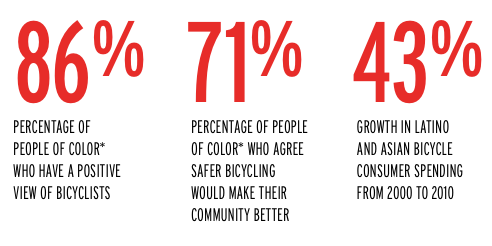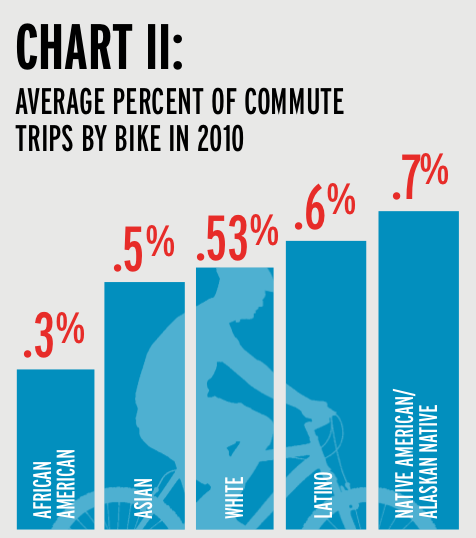SIERRA CLUB
 Bicycling is on the rise across the U.S. Adults are capitalizing on the health and economic benefits of active transportation, while an increasing number of young people are forgoing drivers’ licenses to save money and embrace more walkable, bikeable lifestyles.
Bicycling is on the rise across the U.S. Adults are capitalizing on the health and economic benefits of active transportation, while an increasing number of young people are forgoing drivers’ licenses to save money and embrace more walkable, bikeable lifestyles.
The new majority that elected a president — youth, women and people of color — is playing a key role in pedaling the country toward a more Bicycle Friendly America. These diverse communities are embracing bicycling at a high rate, redefining the face and trajectory of the bicycle movement and the way the nation addresses transportation. An increasingly powerful and growing constituency, previously underrepresented groups are cultivating new campaigns and bike cultures that address the needs, serve the safety and improve the health of all residents who ride — or want to ride. These new riders, leaders and organizations are making biking accessible and inviting to all Americans — while making the case for a safer and more equitable transportation system in communities nationwide.
For too long, many of these diverse populations have been over- looked by traditional organizations and transportation planners. In too many instances, people of color have been largely left out of transportation decision-making processes that have dramatically impacted their neighborhoods. Rising up in response to this dis- enfranchisement, new leaders are rallying against stark disparities in bicycling facilities — and safe streets. These organizations aren’t just engaging new communities in traditional campaigns, but opening new avenues of conversation — shifting the focus from bicycling itself to how bikes address the core everyday issues faced in their unique communities.
Red, Bike and Green chapters are using the bicycle as a means to address health, economic and environmental disparities that disproportionately affect the black community. In Los Angeles, Multicultural Communities for Mobility is working with immigrant worker populations, producing Spanish-language public service announcements and securing bike parking at a day laborer center. In Chicago, Girls Bike Club is making bicycling an integral part of the personal and social lives of young women of color. The Biking Public Project in New York City is giving voice to the often-invisible delivery bicyclist. And these are just a few examples.
 But, while many communities are enjoying new opportunities because of the boom in bicycling, significant challenges persist in many underserved communities. While some residents of a city have access to a variety of transportation options, many communities of color in that same city are in transit deserts that lack safe streets for walking or biking. In fact, according to 2001 data from the Centers for Disease Control and Prevention, compared to white bicyclists, the fatality rate was 23% higher for Hispanic and 30% higher for African-American riders.
But, while many communities are enjoying new opportunities because of the boom in bicycling, significant challenges persist in many underserved communities. While some residents of a city have access to a variety of transportation options, many communities of color in that same city are in transit deserts that lack safe streets for walking or biking. In fact, according to 2001 data from the Centers for Disease Control and Prevention, compared to white bicyclists, the fatality rate was 23% higher for Hispanic and 30% higher for African-American riders.
To address these pressing issues, community groups are developing their own educational and advocacy material catering to the specific needs and cultural understandings of their members because of the lack of ability and interest of larger local, regional and national cycling advocacy to address these expressed needs. There are clear and potent opportunities for transportation planners, departments of transportation at all levels, bicycling advocates, and industry leaders to address the many issues highlighted by this new wave of grassroots leaders in a manner that advances the movement for transportation equity nationwide.
Safe infrastructure for biking will help bring the health, economic, and environmental benefits of biking to those who want to ride but don’t currently feel safe on the streets. These sorts of improvements along with the standardization of safe bike infrastructure design by the U.S. Department of Transportation and other agencies across the country are integral in implementing equitable access to safe infrastructure across jurisdictions.
This report showcases new data and analysis from the League of American Bicyclists and the Sierra Club, as well as compelling statistics and information that highlight the new face of biking in America.
Read full report (PDF) here: The New Majority
About The Sierra Club
www.sierraclub.org
“The Sierra Club’s Mission: To explore, enjoy, and protect the wild places of the earth; To practice and promote the responsible use of the earth’s ecosystems and resources; To educate and enlist humanity to protect and restore the quality of the natural and human environment; and to use all lawful means to carry out these objectives.”
Tags: Cycling, immigration, minorities, Sierra Club, The New Majority: Pedaling Towards Equity







 RSS Feed
RSS Feed